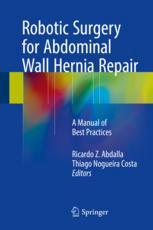

Most ebook files are in PDF format, so you can easily read them using various software such as Foxit Reader or directly on the Google Chrome browser.
Some ebook files are released by publishers in other formats such as .awz, .mobi, .epub, .fb2, etc. You may need to install specific software to read these formats on mobile/PC, such as Calibre.
Please read the tutorial at this link: https://ebookbell.com/faq
We offer FREE conversion to the popular formats you request; however, this may take some time. Therefore, right after payment, please email us, and we will try to provide the service as quickly as possible.
For some exceptional file formats or broken links (if any), please refrain from opening any disputes. Instead, email us first, and we will try to assist within a maximum of 6 hours.
EbookBell Team

0.0
0 reviewsThis book is a surgical manual, intended to present and discuss the use of robotic surgery for abdominal wall hernia repair. It comprises the most important surgical approaches in the field, presenting step by step procedures in a clear and didactic way.
Abdominal wall hernias are very common conditions, easily identifiable in clinical practice and that usually require a surgical intervention as treatment. However, the choice for the right surgical procedure to treat those conditions may vary, provided the diversity on possible techniques, clinical presentations and complexity. Robotic surgery has emerged in recent years as an important tool to increase the number of surgical approaches for the surgeon who faces abdominal wall hernias. Video-assisted and robotic surgery may represent a consistent improvement in options available for the surgeon involved in wall hernia repair. Current robotic surgical techniques present several of the benefits of common laparoscopic surgery features (such as low invasiveness and fast recovery), and adds some other specific benefits, such as more dynamic and precise movements and a much better view of the operatory field.
Robotic Surgery for Abdominal Wall Hernia Repair is intended to help surgeons to manage this disease from another point of view and to choose the best procedures in each case, pushing medical practice to another level of decisions, investigation and follow up, considering the use of new technologies in robotic surgery. It intends to be a reference manual to medical practitioners who has surgical skills in their backgrounds, but that are not familiar with the use of minimally invasive procedures for abdominal wall complex defects.